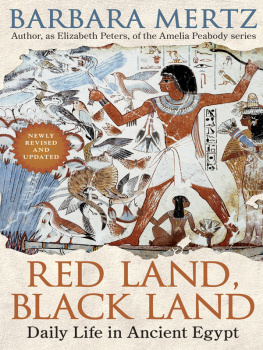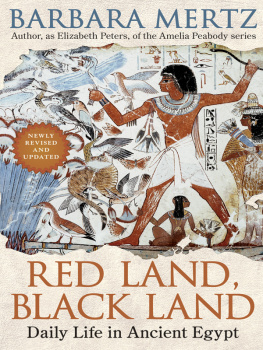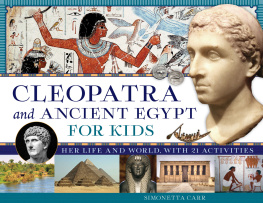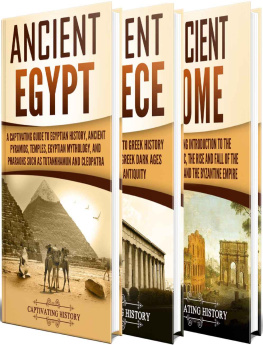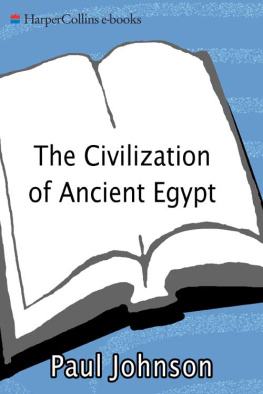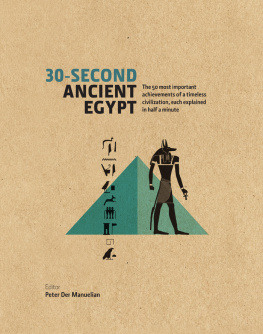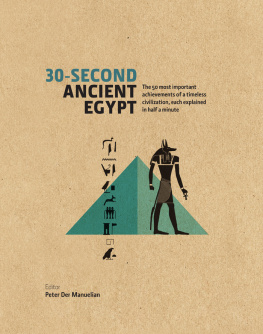Temples, Tombs & Hieroglyphs
A Popular History of Ancient Egypt
Second Edition
Barbara Mertz
To John A. Wilson
18991976
Scholar, teacher, humanist
My affaire de coeur with ancient Egypt began in remote childhood, when I first encountered James Henry Breasteds History of Egypt at the local library; it is still flourishing, although many years and many distractions have intervened. It is necessary to make this highly subjective statement, I think, both to explain the reason for this book and to justify some of the statements which appear herein. There are occasions in the following pages when serious Egyptologists may be offended by what strikes them as a frivolous or fantastical tone. Frivolity there may be; but it should not be taken for disparagement of the field of Egyptology in general or of particular scholars and their pet theories. Few academic subjects are improved by being approached in a spirit of deadly seriousness. I suspect, in fact, that most of them can profit by a bit of kindly mockery, particularly if it is self-administered. That I venture to smile at a field to which I personally adhere above all others should be proof that I act from a general principle, and not from particular malice. They do but jest, poison in jest; no offence i the world.
It is only fair to warn the reader that this is not a history book. It is, rather, an informal study of Egyptologya study of all things Egyptian. My criterion for selection of material has been very simple: I have included anything I found interesting. Hence you will encounter straight archaeological reporting, gossip, and historical theorizing in uneven quantities. You will also encounterI hopepeople. The individual has been rather out of fashion in serious history, although the trend is swinging back in his favor of late. I follow the fairly conventional viewpoint, which holds that events are the product both of The Man and The Background, but I do believe that the shape of events is fashioned by the particular man or woman who holds the reins of destiny at a particular moment in time. Therefore I have frankly and unashamedly talked about people when I was able to do so: about kings and queens for the most part, but also about artists, magicians, and even civil servants.
Any attempt to evaluate, or even describe, the character of a historical personage is difficult and highly subjective; often the biographer inadvertently tells more about himself than about the subject of his biography. In the case of ancient Egyptian individuals it is virtually impossiblein fact, you can leave out virtuallyto do more than speculate. Our knowledge even of events is scanty and incomplete; insight into motives and influences is completely lacking. I have tried to indicate the points at which I leave solid ground and sail off into happy flights of fancy, but undoubtedly I have forgotten to label all the pertinent cases. My consolation is that the same error has been, and is being, committed by professional historians.
I have often speculated as to why so many people are attracted to the study of archaeology. Certain appeals, such as the lure of buried treasure, are fairly obvious; it is to this imaginative human urge that most popular books on archaeology cater. But there is another type of problem involved in archaeology, and in history in general, which also appeals to a wide audiencethe people who like puzzles, riddles, and exercises in simple logic. When we, as students, read a history textbook, we are presented with a series of statements that we accept, with more or less indifference, as true. We do not see the skillful patchwork, the blending together of data from dozens of different sources, which creates a coherent picture of events; and we miss the fascination of following the mental processes by which the patches are matched and hooked together. To follow out these processes in detail is not only entertaining but also profitable, for in the end we find ourselves questioning the sources of certain statements, and even disagreeing with the conclusions which are drawn from them. Here is a consummation devoutly to be wished; the questioning mind should be developed by any person who reads a daily newspaper. I have tried to indicate some of the sources and some of the methods which we apply in order to derive what we call Egyptian history. Many of them transcend Egyptology but are seen just as clearly in this context as in others.
When I first set out to revise this book, I was naive enough to believe several kindly friends, who must have been blinded by affection, because they assured me that I wouldnt need to do very much. As I immediately discovered, I had to do quite a lot. Not only have (good heavens) forty years passed, but they have been years full of new discoveries and new interpretations, and even new characters in the story of ancient Egypt, some of whom were not known when I wrote this book. Contrary to the opinions of the uninformed, revisionism is an integral part of good historical scholarship. It may seem at times that revisionists have gone overboard in their attempts to find new ways of looking at old material, but it is a necessary process.
Despite my disingenuous disclaimer that I had included only material I found interesting, it became obvious to me that I had given short shrift to certain periods and certain topics. Another complication arose from the fact that in the interim I had written another book about ancient Egypt which covered some of the same material. I had to decide what to put in which book.
Having made my excuses I should add that producing a second edition of this book and the other, Red Land, Black Land , has been a great adventure. I have kept up with the field to the best of my ability and made a number of trips to Egypt, but condensing the new material and fitting it into place presented a number of challenges. I hope I have met them adequately; if I have succeeded even in part, much of the credit must go to my many friends and colleagues in the field, not only for their publications but also for the generous advice they have given me. I owe a special debt to Dennis Forbes, editor of Kmt , who took time from his busy life to go over the entire manuscript with his indispensably lethal marking pen. I am also indebted to Roxie Walker for tactfully correcting my misstatements on the subjects of bones and dating skeletons. Kristen Whitbread and Loretta St. John dealt with the electronic issues, if that is what they are called. Thanks to those ladies, I didnt have to call them anything.
This is a traditional, even old-fashioned, history that focuses on people and events rather than on social change. In a way it can be read as a detective story, which sifts through a multitude of clues in order to determine what really happened. There are red herrings, the usual suspects, and detectival historians, for written history is, or should be, a synthesis and analysis of myriad, often contradictory, clues. I mightindeed, I willreiterate my belief that learning to question and analyze so-called facts is the most important lesson a student can learn. It is especially important in todays world, when we are barraged by information from so many disparate sources.
I have avoided the Greek renderings of certain names, such as Khufu instead of Cheops. Ancient Egyptians didnt write the vowels, therefore you will find various spellings of names and other words: Amen, Amon, Amun; ushabti, shabti, shawabti; Harmhab, Horemheb; to mention only a few. There are also variations in the way certain consonants are transliterated: Cush or Kush, Saqqara or Sakkara, and so on. My versions are arbitrary, but so are those of most other people.


